Considering adding dental SEO to your digital marketing strategy?
Then, you’ve come to the right place!
In this blog, I’ll cover some of the top ways you can boost your brand and expand your reach with dental SEO marketing.
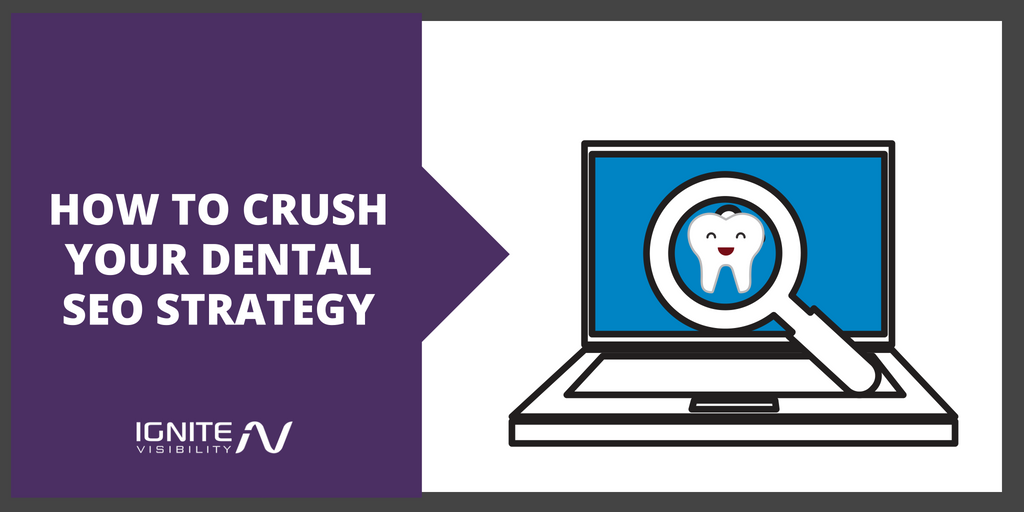
Dental SEO Strategy
Start with Local SEO
SEO comes in many forms. There’s international SEO, ecommerce SEO, and local SEO.
You’ll want to optimize your dental practice for local SEO.
Why? Because you’re running a business that appeals to potential patients in your immediate area.
You can’t package and ship a teeth-whitening service to somebody across the country. People need to visit your office.
That’s why local SEO needs to be your primary means of attracting new business online.
To make that happen, you should follow several local SEO strategies. In this article, I’ll explain some of the most important.
Claim Your Google My Business Listing
When it comes to local SEO, Google My Business is your best friend.
If you haven’t yet claimed your Google My Business listing, now is the time to do so. You’ll be happy to learn that Google makes it very easy to do that.
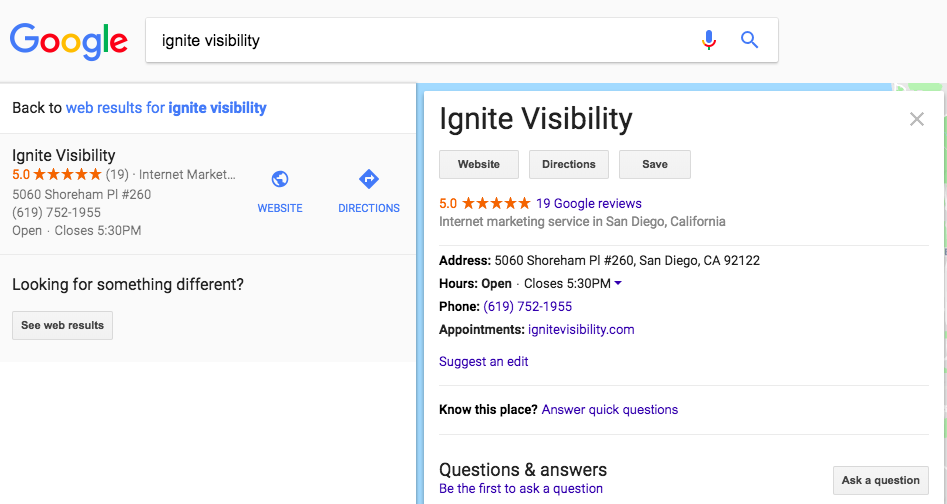
Find and claim your Google My Business listing for dental SEO
The whole process is as easy as searching for your business by its name and address and then claiming it as your own.
Once you’ve done that, you can move to other important dental SEO strategies.
Maintain a Consistent NAP
Here’s the second important tip—make sure that your name, address, and phone number (NAP) is spelled and punctuated exactly the same way wherever it’s listed online.
This is not an option. You can hurt your reach if you don’t do that.
If you spell out your address as “345 Church Street” on your website, then make sure it’s spelled out the exact same way on Google My Business and other web properties. In other words, don’t abbreviate “Street” to “St.”
If you’re just getting started with SEO, it’s not likely that your NAP is listed on a bunch of different websites. In fact, it’s probably listed only on your own website and Google My Business as of now. That makes it easy for you to ensure that your contact info is consistent going forward.
Get Citations
Another important part of local SEO is getting citations.
What are citations? They’re online references to your business. They usually list your NAP.
Fortunately, there are plenty of places where you can get your dental practice listed online. Here are some of the best ones for dentists:
- Healthlocal
- EveryDentist
- eHealthScores
- Medical Device Network
- LabDraw
- Geodentist
- ImplantDirectory
- Dentists.com
- Free Clinic Directory
- The Dentist Hub
- Dentists Directory
- Dentist In Town
- 24 Hour Dental
- Dentist Network
- DentistFind
- Dentist Registry
- Wellness
- 1-800-Dentist
And there are more. Do a Google search on “dentist directory” and you’ll likely find others.
You’ll have to go through the process of manually adding your listing to each of those directories. If that’s too tedious, offload the task to an assistant. It might even be a good idea to hire a virtual assistant (VA) for that sort of thing.
Also, look for directories in your area. They don’t have to be dental-specific.
You might find a website that lists businesses in your town or city. Reach out to the webmaster and ask if you can list your business there. That’s another citation.
Remember the previous rule, though— always keep your NAP consistent!
Get Some Positive Reviews
Sometimes, when people search for a nearby dentist, Google will show them a “local pack.” That’s a highlighted listing of local businesses that match the search criteria.
That local pack is also digital gold. You want your dental practice to show up there (preferably at the top) when people search for “dentist” plus the name of your town (for example: “dentist in Raleigh”).
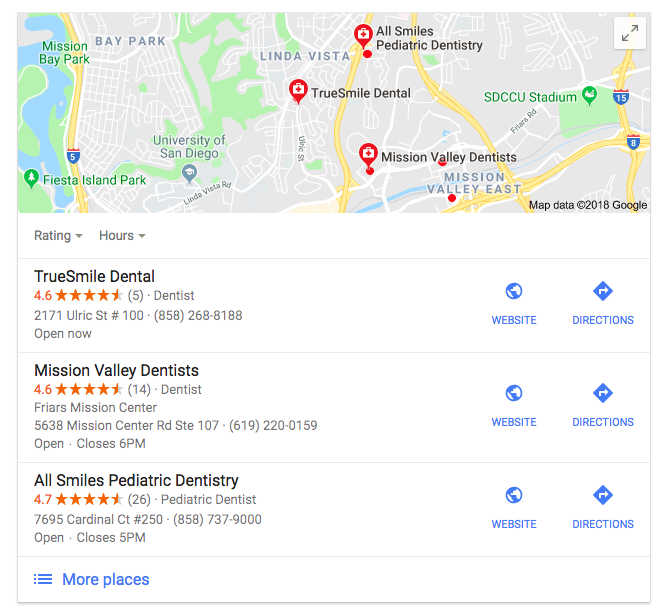
Get in Google’s local pack for better dental SEO
One of the ways that Google determines which businesses get the top spots in that local pack is by evaluating reviews. Since Google likes to provide its users with a positive experience, it will prioritize businesses with the best reviews.
So here’s your next task— go get some positive reviews.
One of the best ways to do that is to simply ask happy patients to leave a positive review. Google is okay with that.
Send each patient an email a few days after a visit. In that email, include a link that the patient can click on to leave a review. That’s all you need to do.
Or, use a review generation software designed to automate the contact and review collection process for you.
Just be sure that you don’t offer any incentive in exchange for a positive review. That could be construed as a bribe and you could lose rank.
Add a Description of Your Business
Google My Business also gives you the option to add a description of your business. Do it.
You can include up to 750 characters telling everybody about why you’re such a great dentist. Be sure to include keywords relevant to your practice.
That’s especially a good idea if you’re a specialist. For example, if you handle reconstructive surgery or orthodontia, make sure you include the appropriate buzzwords and search phrases in your business description.
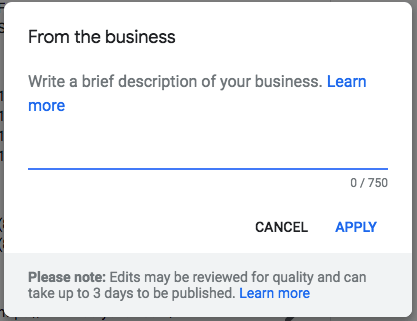
Include a description for better dental SEO
I’ll cover more about keywords a little bit later.
Keep in mind—although you can add up to 750 characters to describe your business, only the first 250 characters show up in search. That means you want to put your best work into those first 250 characters.
If you don’t know how to promote your business in a concise way, it might be a good idea to hire a copywriter.
Get Responsive
It’s the mobile era, which means that many of your customers will likely be searching for a dentist on their smartphones.
If they find your listing, they’ll likely visit your website. That’s why you need a website that looks terrific on a mobile platform.
Folks in the web development industry call that a “responsive” website. It’s called that because it “responds” to a screen of any size and formats the layout accordingly.
If your website looks fine on a desktop, but doesn’t adapt to the small viewport of a mobile phone, you’re in trouble. You’ll need to get a redesign.
Otherwise, people who view your site on a mobile device will have to pinch and squeeze just to see what’s on your homepage. They won’t like that and you’ll lose business.
So do yourself a favor—get a website template that looks great on any platform.
Create Educational Videos
You probably already know that the most popular search engine is Google. But do you know what the second most popular search engine is?
Believe it or not, it’s YouTube.
So here’s a nice way to stand apart from the competition— make great videos and optimize them for keywords related to your practice.
Keep in mind—Google owns YouTube. That’s why you’ll sometimes see YouTube videos at the very top of the search results in a carousel.
Usually, it’s best to use YouTube videos to demonstrate your expertise. That way, people will be more inclined to believe that you can help them with their dental issues.
Here are a few ideas about how you can demonstrate your expertise as a dentist in a YouTube video:
- Show people how to floss properly
- Show people how to brush their teeth properly
- Explain why some toothpastes are better than others
- Explain how braces fix common alignment problems
Also, if you can get one or more patients to leave a video testimonial, that’s an outstanding way to promote your business with social proof. Just be sure you find people who have great-looking teeth!
In the description of your video, link back to your website. Also, include the URL for your site at the beginning and end of the video itself.
One final point— making videos isn’t always cheap. That’s especially the case if you’re demonstrating proper flossing techniques with images and animation. So be prepared to open your wallet.
Dental SEO Content Marketing
If you think that creating videos is outside of your immediate SEO goals, don’t worry. You can still create content that attracts visitors.
Add a blog to your website (if you don’t have one already) and write articles that show off your knowledge as a dentist.
There are a couple of rules, though. First, write in a conversational style that most people can understand.
If you write an article that’s written like it belongs in a peer-reviewed journal, you aren’t going to appeal to people in your target market. Make your content easy to read.
Second, optimize your content for keywords related to your practice. For example, if you want to explain how to floss, write an article with a title like—“How to floss your teeth (tricks that most people don’t know).”
In that article, explain the basics of flossing and add in a few pro-tips that most non-dentists don’t know about.
That title, by the way, is optimized for “how to floss” or “how to floss your teeth.” Make sure you include that keyword in the first paragraph of your article and sprinkle it throughout the content naturally. That’s how your article will rank for the search term.
Do the same with other keywords related to your practice. As a rule of thumb, it’s a great idea to create one article for each keyword.
Use Regional Keywords
If you’re running a business in Raleigh, NC, then make sure that “Raleigh, NC” appears in your title tags.
In fact, you might just want to make the title of your website “Dentist in Raleigh, NC.” That could be more important than the name of your practice.
Why? Because that’s exactly the phrase that a lot of people in Raleigh, NC will use when searching for a dentist. They probably won’t search for your business name.
Sprinkle those regional keywords throughout your homepage. Also, make sure they appear prominently in your “About Us” and “Contact” pages as well.
Find Relevant Keywords
Beyond regional keywords, you also need to populate your site and your content with keywords relevant to your practice. That’s important if you want to attract more business.
First, write down all the search terms that you associate with your business. Examples include:
- Teeth whitening
- Teeth cleaning
- Cavity filling
- Orthodontia
- Reconstructive surgery
- Pediatric dentistry
Once you’ve completed your list, prioritize them in order of importance. For example, if you primarily handle pediatric dentistry, then that search term would appear at the top.
Next, make sure that the top search terms appear in your title tags, your homepage, and your “About Us” page.
For example, if you specialize in teeth whitening and teeth cleaning, your title tag might look something like this—“Teeth whitening and teeth cleaning in Raleigh, NC.”
Also, be sure to include those popular keywords in your description on Google My Business.
Finally, create a separate “service” page for each type of service you offer. Optimize that page for the keyword.
For example, if you specialize in teeth whitening and teeth cleaning, you would create two service pages—one for teeth whitening and one for teeth cleaning.
The title tag for the first page would be “Teeth Whitening in Raleigh, NC.”
The title tag for the second page would be “Teeth Cleaning in Raleigh, NC.”
Each page would describe the service in detail, using the appropriate keywords.
At this point, you’ve just handled the basics in terms of keywords. Now, it’s time to move on to keyword research.
Keyword Research
Although you might think that you’ve used all the search terms related to your practice, you’ll find that good dental SEO requires you to do some keyword research. Fortunately, there are plenty of ways you can do that.
One option is to pick up a tool like SEMRush. That’s a great option for two reasons.
First, you can find keywords related to the search terms you already identified. For example, you can use the tool to identify keywords related to “teeth whitening” or “teeth cleaning.”
Perhaps a better way to use the tool, though, is to find out which keywords your competitors are using to rank. Then, you can “steal” their keywords and use them for your own business.
You don’t have to limit yourself to competitors, though. Take a look at which keywords dentists in other cities are using to rank. You might pick up some great ideas that way as well.
Sadly, SEMRush isn’t free. If you don’t want to spring for the monthly fee, there are other ways that you can find great keywords.
In fact, you might want to use some of those other ways even if you do have SEMRush.
Let Google Find Your Keywords
Sometimes, you can find some great keywords for dental SEO just by searching for your own keywords with Google.
For example, I just searched for “teeth whitening” and saw an AdWords ad with this title: “Advanced LED Teeth Whitening.”
That keyword is way more specific than just “teeth whitening.” If you offer advanced LED teeth whitening, you should create a service page and optimize it for that term.
I also saw another AdWords ad with this title—“Want a Brighter Smile?”
Again, that’s a great title for a service page. Use it.
Look for Long-Tail Keywords
When it comes to dental SEO, one of the best things you can do for your site is optimize it for long-tail keywords.
If you’re unfamiliar with long-tail keywords, they’re search terms that are four words or longer.
Long-tail keywords are great for a couple of reasons. First, they’re often used by people searching for a dentist in your area. Second, your competitors might not know about them.
Let’s face it—quite a few dental practices in Raleigh have probably optimized for “dentist in Raleigh.” That’s a crowded field with a competitive search term.
But how many of them have optimized for “dentist in Raleigh accepting new patients?”
Probably not as many.
The trick is to find search terms that are popular with Google users but not so well-known among your fellow dentists. That’s not always easy.
One of the best (and cheapest) ways to find those long-tail keywords is to let Google tell you about them.
Just go to the Google search bar and start typing one of your basic keywords. You’ll find that Google does an auto-complete that shows you some long-tail keywords.
For example, I typed “dentist in Raleigh” and Google auto-completed several options. One of them was “dentist in Raleigh NC open on Saturday.”
Bingo! If your business is open on Saturday, you just found a longtail keyword.
How do you use that long-tail keyword? Create a service page just like the others and optimize it for that phrase.
Other Ways to Find Long-Tail Keywords for
Besides using Google auto-complete, there are other ways that you can find long-tail keywords. I’ll go over a couple of them here.
Soovle. is a neat tool that can help you find overlooked keywords. Some of them are long-tail.
Even better—Soovle is free.
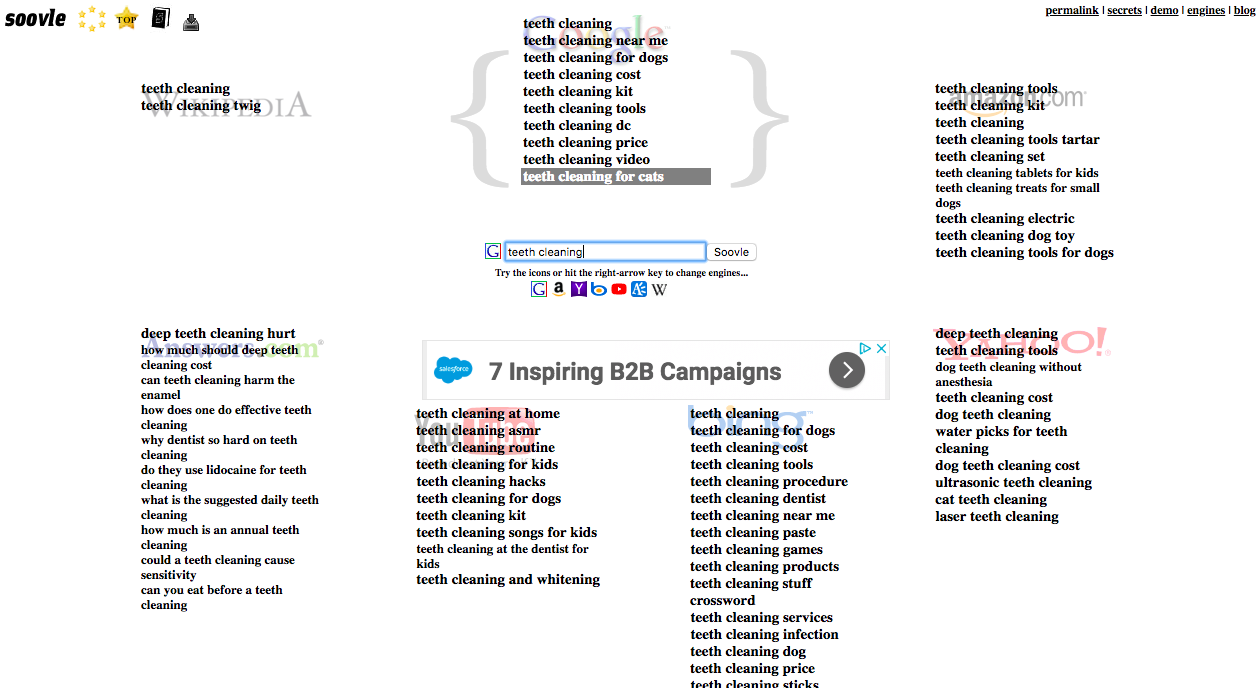
Use Soovle to find long-tail keywords for dental SEO
Another freebie you can use to find long-tail keywords is KeywordTool.io. You’ll have to pay for it if you want to see search volume, though.
I went there and did a search for “teeth whitening.” One of the results I found is “teeth whitening after braces.”
Again, that’s a great long-tail keyword that people are searching for. Your competitors might not even know about it.
Look for Keywords With Purchase Intent
Remember—as you look for keywords related to your practice, not all of them will bring you more patients.
You might optimize a video for “how to floss teeth.” That will get you some views on YouTube and show off your expertise as a dentist, but it won’t necessarily get you any patients in the short run.
On the other hand, “kid-friendly dentist” is a keyword that’s going to be used by a parent who’s searching for a pediatric dentist. That will likely get you some more patients.
So here’s the game plan— optimize your site for keywords that people will use when looking for a dentist. Then, after you’ve done that, start creating videos and other content that will promote your brand and your expertise.
Add Backlinks
Finally, get some backlinks to your website.
What are backlinks? They’re links to your site from other websites or blogs.
They also give you credibility with the search engines. Backlinks help you rank better for keywords related to your niche.
Ideally, you want links from popular sites. But it’s not always easy to get a link to your site from the New York Times or Wall Street Journal.
You’ll likely have to settle for some not-so-well-known sites.
Start by looking at the websites of non-competing businesses in the area. Then, propose a link exchange to the webmasters of those sites—you’ll give them a link to their sites if they give you a link back to yours.
You can usually meet fellow business owners a local Chamber of Commerce meetings if you’re brand new to town and don’t know anybody yet.
Another way to get a backlink is with guest-posting. Find some websites that specialize in health care broadly. Reach out to the webmasters and ask if you can post an article about dental hygiene.
They’ll often comply because they need content from healthcare professionals.
Somewhere in your content, link back to your own site. You can even include the link in your signature section that explains who you are and why you’re qualified to write about dental hygiene.
Wrapping Up
There you have it—now you’re a resident dental SEO expert!
Although there’s quite a bit in this article, the longest journey begins with the first step. Start by tackling the easiest tasks first. Then, move on to the more challenging ones.
After a while, you’ll have a waiting room filled with new patients…all thanks to your winning dental SEO marketing strategy.
Frequently Asked Questions
Why do dentists need SEO?
If you want to grow your dental practice, dental SEO marketing is the way to go. SEO is one of the most reliable and valuable marketing tactics because—when implemented correctly—it can place your practice in front of the right people at the right time. And the faster new patients can find you organically, the more likely they are to convert.
What is a dental SEO partner?
A practice will typically hire a dental SEO partner when they want to manage their online presence and grow their business. Their service offerings often span SEO, web design, Facebook Ads, Google Ads, and more.
Can I hire a dental SEO company?
Of course you can hire a dental SEO company! If you want more patients and higher profits, there are marketing agencies dedicated exclusively to dentists, focusing on services that aim to grow dental practices.